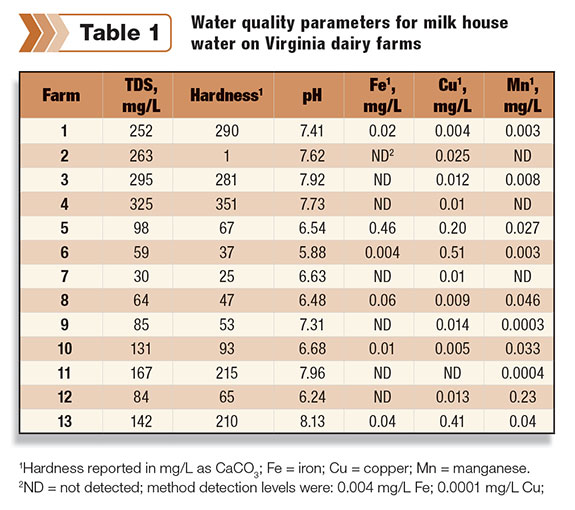Lactating dairy cattle require large amounts of water to produce milk. Though water is one of the most important nutrients for dairy cattle, water quality is often overlooked. Water, other than providing hydration, can also supply minerals vital for bovine health. Mineral composition can vary in water based on region and water source.
Sometimes minerals are present in excess. Some minerals, like iron, are monitored based on EPA-regulated categories called secondary maximum contaminant levels (SMCL), which are not enforced.
Iron levels in groundwater across the U.S. have been found to exceed the EPA level of 0.3 milligram Fe per liter (0.3 mg per L), which affects the way water tastes.
In a recent research project at Virginia Tech, we demonstrated that iron intake up to 1,250 mg per day for 14 days were safe for early lactation dairy cattle, but processed milk from those cows was susceptible to flavor changes.
The concentration of iron and other minerals is highly variable in water, making it difficult to relate dairy cow health to mineral sources in the drinking water. Geological structures in the region can affect mineral content of the water.
We wanted to determine how much variation in iron content occurred on Virginia dairy farms. In the summer of 2012, Katherine Phetxumphou, a graduate student in Virginia Techâs department of Civil and Environmental Engineering, and Emily Gibson, an undergraduate student in Environmental Science, collected water samples from 13 farms across Virginia.
Using a portal multiprobe, we took on-site measurements of the pH, amount of oxygen in the water (dissolved oxygen percentage), total dissolved solids, conductivity and temperature of the water.
Water was collected directly from the milk-house faucets and outside water drinking troughs accessible to the cows. The collected samples were transported to the VT Taste and Odor Lab in the Civil and Environmental Engineering Department for mineral analysis using sensitive instrumentation.

The instrument measured 20 metals, most importantly, iron.
We did not test for any biological contaminants.
Water quality parameters varied from county to county and from site to site (see Table 1 ). Several farms had hard water.
Two farms (5 and 8) had high iron, above the EPA SMCL of 0.3 mg Fe per L water. Farm 12 had high manganese.
These levels may be naturally occurring in the groundwater from the weathering of iron-bearing and manganese-bearing minerals and rocks.
Nearby industrial effluent, acid-mine drainage, sewage and landfill leachate may also be contributing factors to the high iron and manganese levels on these dairy farms.
Farm 5 was unique in that this farm had two different water sources with two different iron levels consumed by two separate groups of cows. Water samples were collected from freestall water troughs supplied by the two wells.
After allowing a few minutes for the collected water to settle, the high-iron samples appeared contaminated with a slight orange hue. Iron concentration in the water was 0.014 mg per L and 0.99 mg per L for the low-iron and high-iron waters, respectively.
This provided us with an opportunity to study the effect of long-term exposure of lactating dairy cows to iron above the EPA SMCL in drinking water.
Milk from the cows on this farm was collected for Dairy Herd Information Association (DHIA) analysis. We were granted permission to test those samples to determine if there were any notable effects of the water on milk.
Milk weights were recorded by a DHIA technician and tested in the DHIA labs for fat composition, protein, nonfat solids and somatic cell count. At the time of sampling, there were 340 lactating cows between the two groups of cattle within the herd.
Georgianna Mann, a graduate student in the Department of Food Science and Technology, further analyzed milk samples for oxidation susceptibility and mineral content.
After analysis in the DHIA lab, Mann pooled samples in their respective treatment categories (low-iron versus high-iron) before assessing oxidative stability and mineral content. Iron, copper, calcium and inorganic phosphorus content of the milk samples were determined.
Results revealed no significant differences between the high-iron and low-iron water treatments in oxidative stability or mineral content.
However, one noted difference between the treatments was that the milk yield was higher for the low-iron- treated cows. This could be due to the iron levels in the water, but the two herds were separated based on health status and lactation number.
Cattle that had recently calved or were sick had access only to the low-iron water source. The cattle on the high-iron treatment were cattle in a later lactation stage and producing medium volumes of milk.
The results of this case study suggest that iron levels in water may have an effect on milk yield, but more research is necessary to eliminate the possible influence created by cattle health and lactation stage status.
Mannâs graduate research has shown that processed milk from cows receiving short-term (two weeks) elevated iron levels tastes different, suggesting that changes in iron content of the water might affect milk quality.
Extra testing of milk can help determine effects of excess levels of minerals. Ultimately, abundant, high-quality drinking water is essential for dairy cows.
Continuous on-farm water testing is essential for animal health to provide adequate and acceptable water for optimum milk production. PD
Mann is currently a graduate student at Virginia Tech in the human nutrition, foods and exercise program. Phetxumphou and Gibson are students and Martel is an extension agent at the same institution. Duncan, Dietrich and James and Knowlton have Ph.D.s in their respective fields and are professors at Virginia Tech.
âExcerpts from The Virginia Dairyman, June 2013

Georgianna Mann
Graduate Student
Virginia Tech





